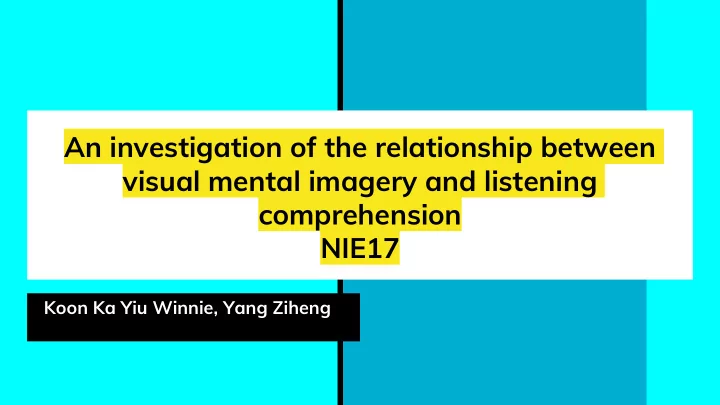

An investigation of the relationship between visual mental imagery and listening comprehension NIE17 Koon Ka Yiu Winnie, Yang Ziheng
Introduction Our study aims to study the nature of visual mental imagery by ● investigating the correlation between one’s visual mental imagery and listening ability. With analysis on how people have different visual mental imagery ability ● and listening comprehension, we have drawn a conclusion which could be useful both for future direction of research and for its applications in education areas.
Introduction The flowchart below displays how our research progressed. ● Examine Use forensic arts Study the nature different people’s and advanced of visual mental visual mental quantitative imagery that is imagery and their techniques formed listening ability
Methodology Participants : 30 participants from two junior colleges. ● English listening test. A standardised English listening test was ● administered and the scores recorded. Audio . Three audio excerpts, each containing a descriptive paragraph. ● Participants would describe to the artists what they had seen in their minds after listening to the audio. Drawings. Artists drew out participants’ mental image by closely ● following their descriptions.
Some drawing samples
Methodology Visual Mental Imagery Analysis Tool (ViMIAT) : to quantify visual mental ● imagery, including 16 dimensions. E.g. number of scenes, history, clarity, completeness, details, embedded emotions, shape crowdedness, shape-added features, shape naturalism/distortion, texture, space, time and motion, colour, balance, rhythm, and emphasis. Scores are given for all dimensions for all drawings. ●
Methodology SPSS software : correlation analysis and Cohen’s Kappa in the SPSS. ●
Methodology Latent Class Analysis : suitable for smaller sample size to find out whether ● there are any distinct groups of imaginers.
Methodology Three models were firstly chosen to fit our results. Using the Akaike ● Information Criterion (AIC) and Bayesian Information Criterion (BIC), we chose the best model among the three chosen.
Data Analysis and Results Agreement of scores for ViMIAT by two artists ● Analysis tool used Lowest value in the Highest value in the range range Correlation Analysis 0.237 (texture) 1 (number of scenes) Cohen’s Kappa 1.651 (Naturalism & 5.477 (History) distortion)
Data Analysis and Results AIC and BIC results for three chosen models ● Model 2 is therefore chosen as the best-fit model to use. ●
Data Analysis and Results Graph of model 2 ●
Data Analysis and Results From model 2 graph, 7 out of 16 dimensions (clarity, completeness of ● figures, details, shape crowdedness, texture, time and motion, colour) were significantly different from one another. Thus, at least 7 of these dimensions are measurable in the way that people ● have various abilities in these dimensions.
Data Analysis and Results This indicates that while their visual imagery were significantly different ● from each other’s, there was no conspicuous difference in their listening abilities.
Conclusion There is no correlation between one’s VMI and listening comprehension. ●
Conclusion Comparisons with another similar study from Aryadoust (2019): ● 1. The two studies agree that elements, rhythm, balance and emphasis, did not differ among imaginers; 2. The study from Aryadoust investigated different samples, and found significant relationship between VMI and listening ability.
Conclusion Our study is one of the first which has shed light on the structure of VMI. It ● shows that VMIs are measurable, but sample chosen matters. Future research can employ larger and more diverse samples to address the limitations of the present study.
Main References Aryadoust, V. (2019). Listeners’ visual mental imagery and its relationship with oral ● comprehension: Evidence from forensic arts and clustering techniques. Imagination, Cognition and Personality, X, XX-XX. Kosslyn, Ganis & Thompson. (2009). The Case for Mental Imagery. ●
Thank you!
Recommend
More recommend